'Bridgerton' Features 7,500 Glorious Costume Pieces
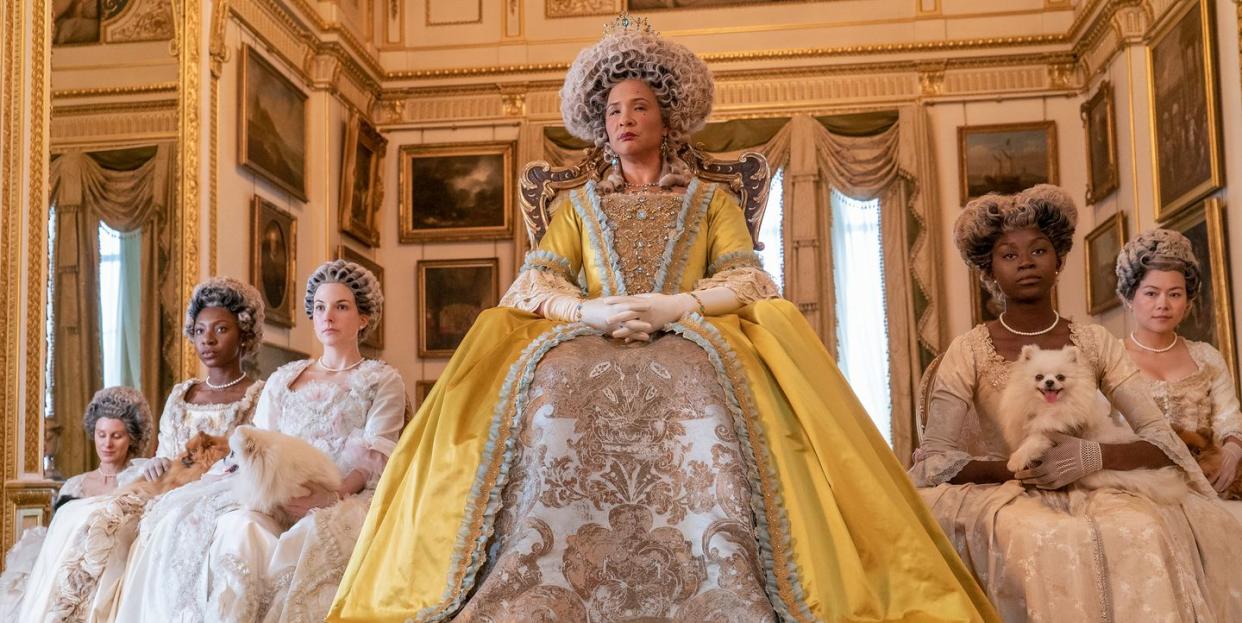
Bridgerton was no small feat. Shonda Rhimes went all-out with her debut Netflix series, a flashy period piece set in 1813 Regency England complete with royalty, towering manors, formal balls, and elaborate practices of courtship. A large ensemble brings the show’s intricate, Rhimes-level drama to life. So how does one dress them all in such decadent, exquisite 19th century clothing? “The challenge really was, how do you create this world, logistically, in the reality of it?” costume designer Ellen Mijornick tells BAZAAR.com.
What helped ease the process was having a prior relationship and being “aesthetically compatible” with Shondaland. “[With] something this size, it's comforting to know that we're on the same page,” Mijornick says. Her costume team and the production company worked closely together to keep track of what pieces were needed, what was being created, and how it would be made.
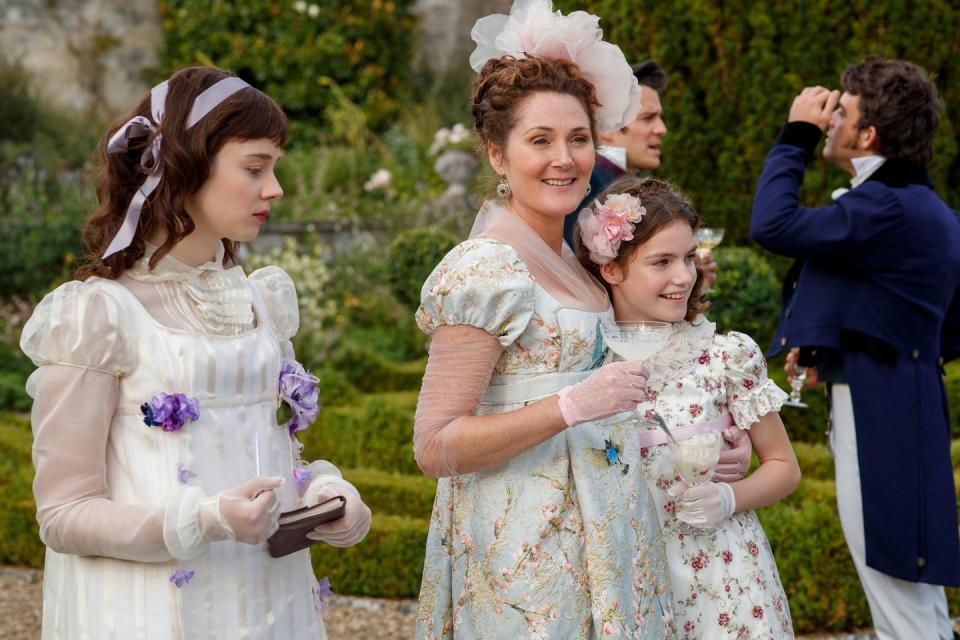
For Mijornick, the challenge wasn’t just the size of the cast, it was the depth of the story. In just eight episodes, there would be ten balls, which would require a lot of gowns, tiaras, and tailcoats. “And although we have fictionalized the Regency period, 1813, there's still there basic truth. Meaning the girls changed their clothes a lot," she said. "They wore a different dress to every ball, aside from the amount of dresses that would take place from morning ‘til dinner. So we knew just roughly that this was going to be a large, large endeavor.”
The end product is a resplendent, lavish wardrobe full of empire waist dresses in sweet pastels with delicate embroidery; evening gowns dripping in shiny embellishments; frilly lace numbers with sheer puff-sleeves and ribbon details; royal fineries with brocade patterns; and lots and lots of jewels.
“We put a lot of people to work and the results were fabulous,” Mijornick says. Here, she spills on the Bridgerton costumes.
There were about 7,500 costume pieces.
“Basically, all together, inclusive of our principal wardrobe, there were costume pieces equaling 7,500,” Mijornick tells BAZAAR. That number refers to individual items rather than full outfits, such as multiple overlays that make up one dress, or a piece of outerwear. “It's kind of like cooking,” she explains. “You need to have the ingredients to be able to make the costume that's necessary.”
Still, the number is staggering. Mijornick believes there were about a thousand pieces for the principal characters alone, counting items such as capes, undergarments, and so on. Leading lady Daphne Bridgerton, played by Phoebe Dynevor, had a whopping 104 costume changes.
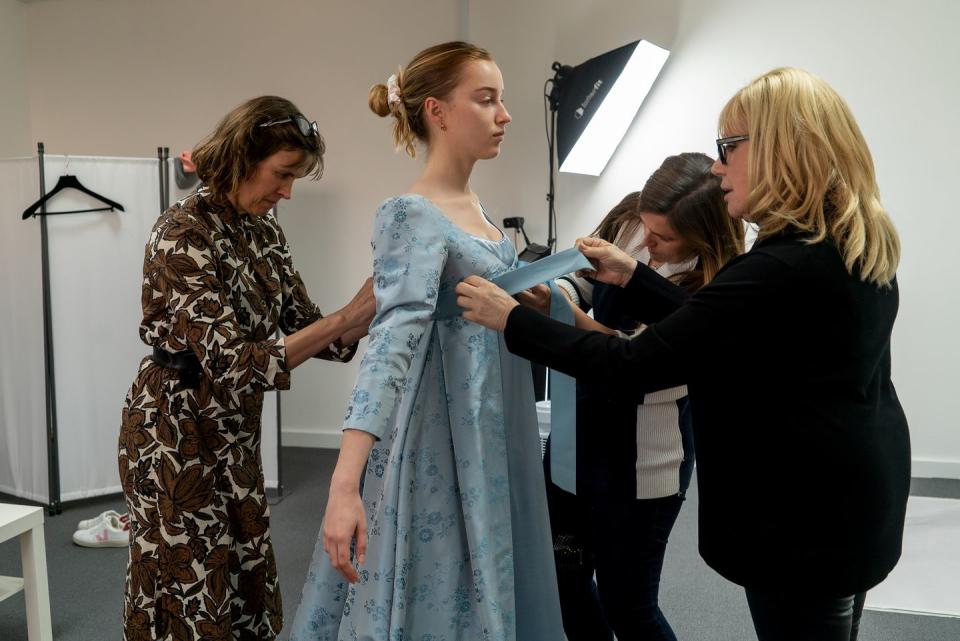
Mijornick’s team hired five cutters to make patterns and construct costumes for the principal roles, as well as two tailors. “Everything was basically bespoke, and so much hand-embroidery, beading, I mean, this was quite a glittery show,” she says.
For the background wardrobe, the team had to create their own costume house with clothing from companies from around the world, including Angel Costume Company in England, Peris Costume Company in Spain, Tirelli Costumi in Italy, and even some manufacturers in New York. They used this stock to dress the background characters, secondary players, and, if needed, quick-changes for principals.
Let's not forget the bling. Jewelry was sourced from dealers in New York, Italy, and the U.K. An artisan and jewelry designer, Lorenzo Mancianti, was also on the team making pieces throughout the show. The tiaras were sourced in Italy and the U.K., and the principals’ tiaras came from the Swarovski Archive.
“I've been doing this a long time and I never [saw something] like this,” Mijornick says. “I guess it goes back to the days of Ben Hur and Cleopatra and those biblical epics, but now we're in Regency England and the numbers are just as large.”
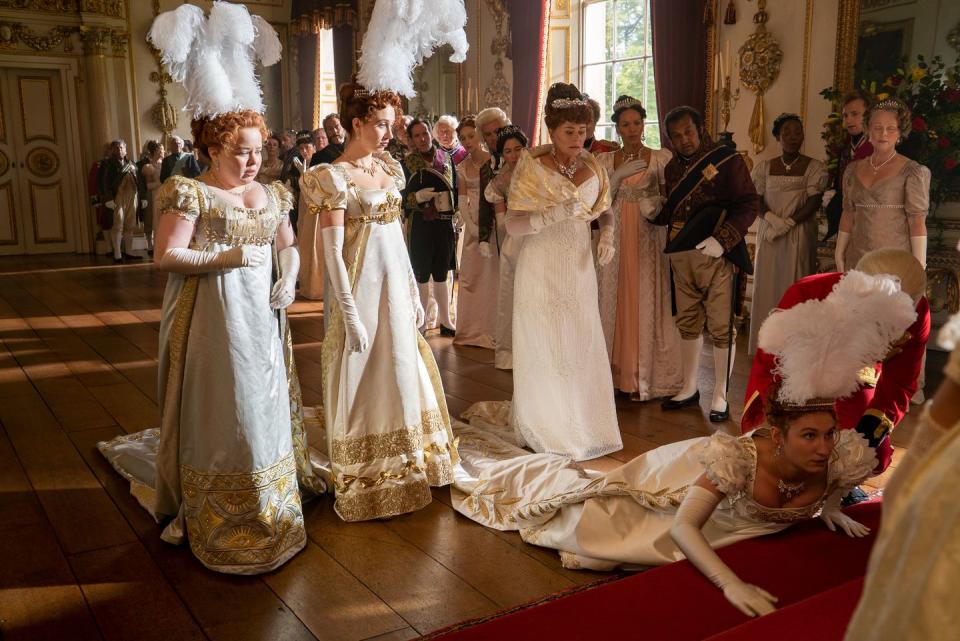
Mijornick and her team put a modern twist on Regency attire.
The fashion in Bridgerton is an interpretation of what people would have been wearing at the time, but with a contemporary upgrade. For example, the Featherington family wears floral prints in bright pinks, yellows, and oranges, which feel more 2020s than 1810s. And the heavy jewel embellishments on the gowns are more extravagant than they would have been in the actual time period.
Mijornick wanted to overlay the look of the Regency era “with a bit of a modern sensibility, make it aspirational, intriguing, and with somewhat of a layer that would actually be very imaginative.”
She summed it up with a relatable analogy. “If you open up a Harper's BAZAAR magazine of December 150 years ago, or a hundred years ago, it would be dull, it would be faded, the pages could be yellowed, and it could be kind of tattered, right?” she says. “But when you open up Harper's BAZAAR today, it's crisp, it's clear, it’s hued, it's either intense or pale or however the photographer feels about the subject that is being photographed. It's rich and it's of the moment and it's clean, right? It's the same thing of doing a Regency-infused show now, as opposed to replicating the exactness of the period.”
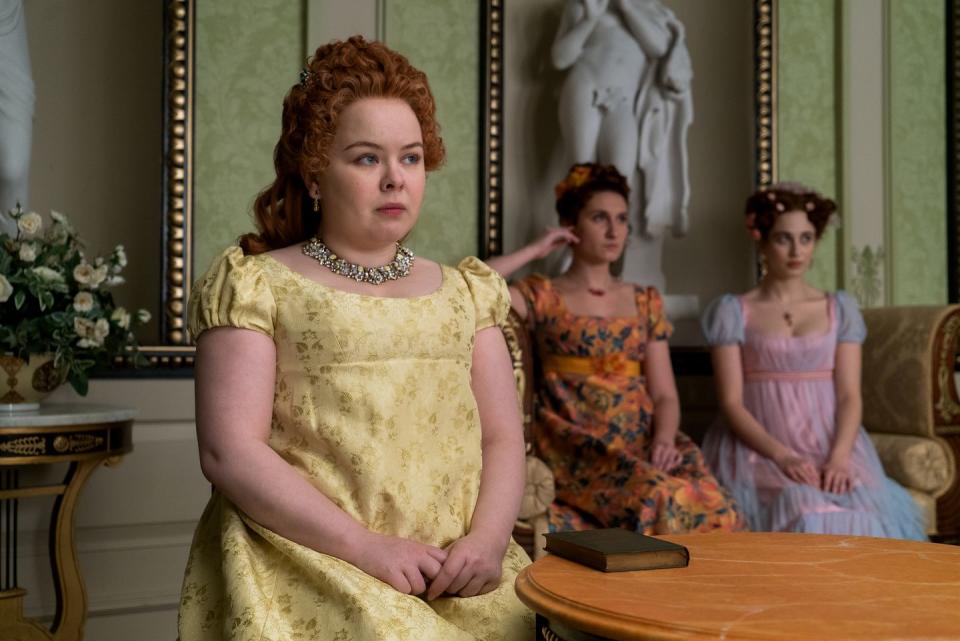
The intention with the show was not to make a historically accurate account. There were some 1810s fashions that "translate beautifully" for 2020 viewers, Mijornick admits, but the rest were upgraded for the show. "We have increased the amount of glitter, increased the amount of color, increased the over embellishing. We have done things that actually can relate a little bit more to today's point of view.”
Also making the show more modern and relatable is its diverse cast, which places representation in a genre that’s been historically white-washed. Roles of nobility such as Queen Charlotte (Golda Rosheuvel), the Duke of Hastings (Regé-Jean Page), and Lady Danbury (Adjoa Andoh), and members of the ensemble are played by Black actors. And when it came to styling, some actors wore natural Black hairstyles with their Regency costumes. The costume department worked with the hair and makeup teams to let these hairstyles shine on screen.
“The overall concept for the Bridgerton world allowed for an unconventional approach to just about everything,” Mijornick says. “Our first conversations regarding character design always included hair and makeup. After studying our look books and discussing design direction, everyone interpreted historical references into our ‘new norm’ for the show. The hair and makeup designers were on exactly the same page and followed suit.”
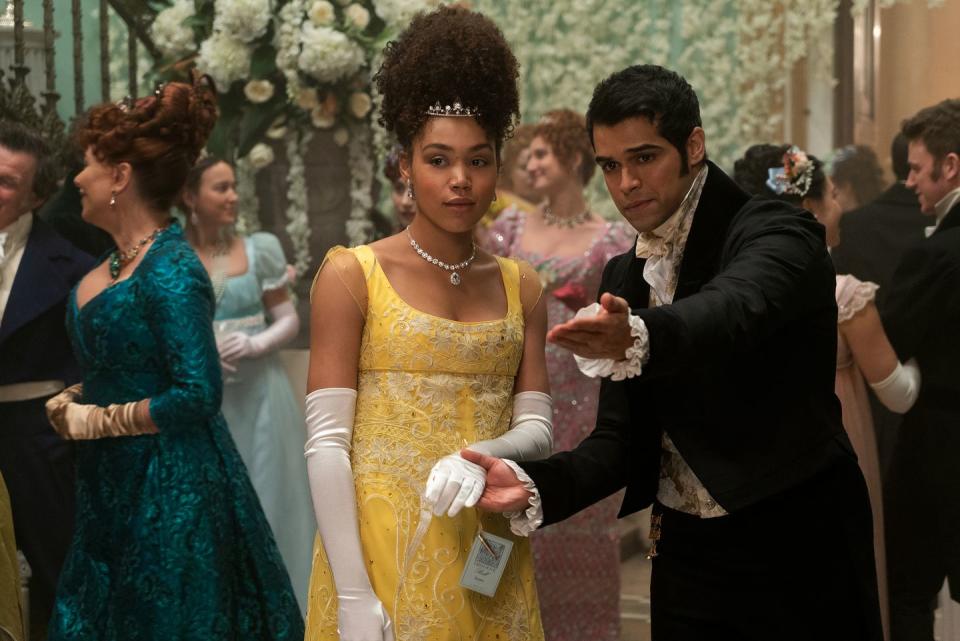
Now, about those corsets…
The famous corset maker Mr. Pearl was behind the body-hugging undergarments on the show. “[There are] no two bodies that are alike. And so if there is a bosom or a shape, even at the top part of the body that has to be adjusted for the costume, he knows how to create that structure to be able to give you that,” Mijornick says of what makes Mr. Pearl’s style unique. “The gowns would not fall over the body if there was no structure underneath that.”
The show includes cheeky nods to how uncomfortable the corsets were at the time. Women gasp for air when the laces are pulled taught; others blister around the edges of the garment. How comfortable was it—or wasn’t it—for the actors wearing the pieces in real life?
“I don't think comfort comes into the conversation,” Mijornick laughs. “We try to make it as comfortable as possible, but it isn't as comfortable as wearing a sports bra—no how, no way.”
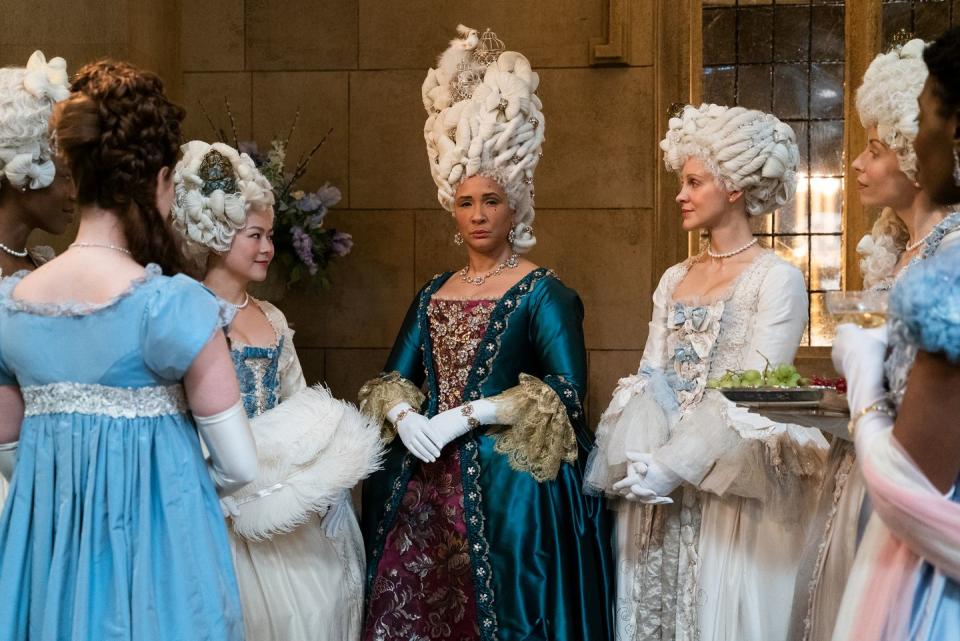
However, they did mostly use half corsets, which extend to the top of the ribs, rather than full-body corsets, which extend down to the waist and feel more restricting. Staying true to the time period, the focus of the silhouette, thanks to these corsets, was the bosom. “And so the corsets were made so that there is a pushup and a blossoming effect on top of the top of the neck line,” Mijornick says.
The actors just had to get used to wearing the undergarments. “But as an end result, they wore it with as much grace as I've ever seen,” adds Mijornick. “They were, I think, far more comfortable than they ever thought they'd be.”
This interview has been edited and condensed for clarity.
You Might Also Like

